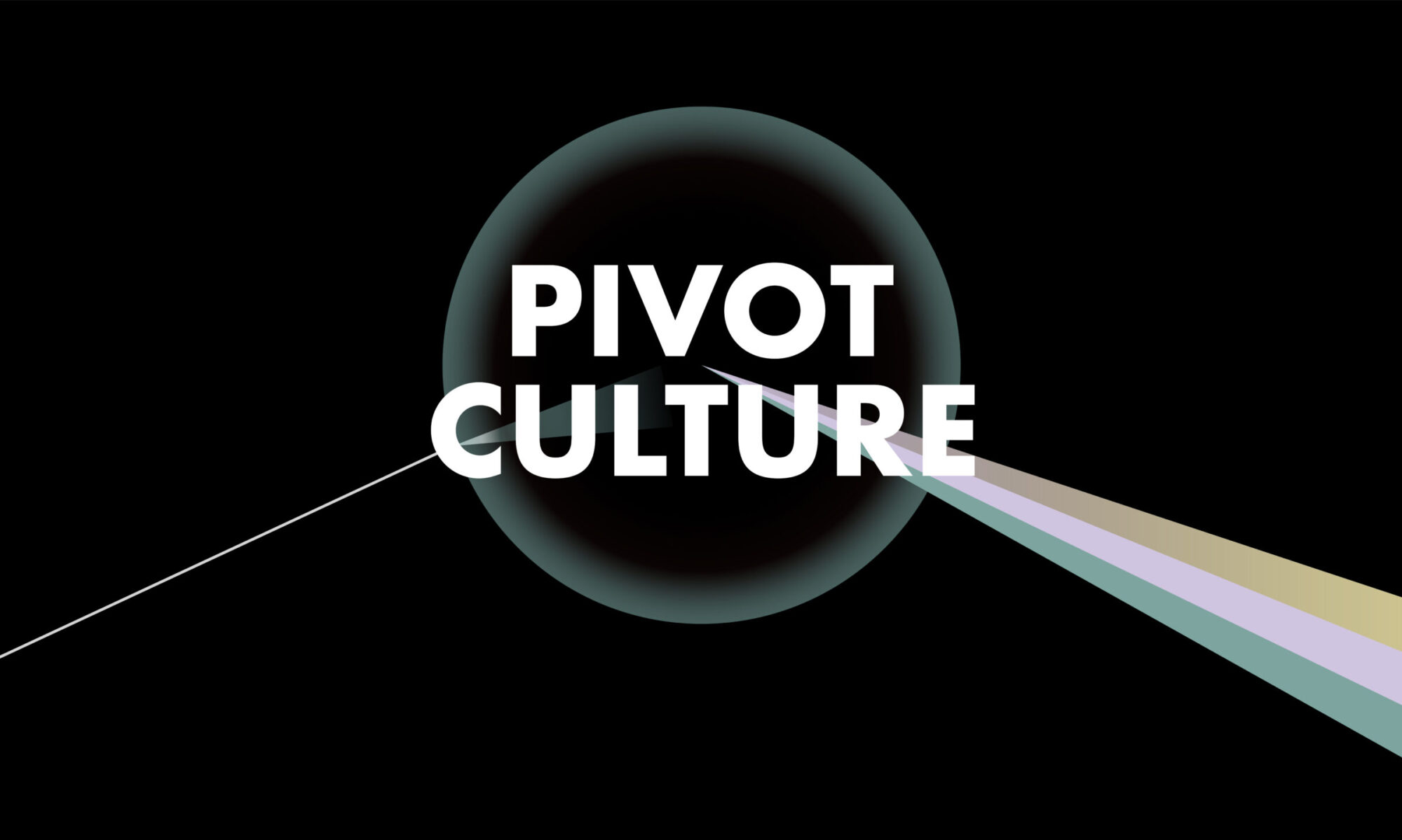Qian ZHAO & Pengyu ZHU , Zixu CHEN 赵乾 & 朱鹏宇, 陈子绪
After experiencing the pandemic, they have changed from focussing on the ideal to reality in their daily lives. In terms of their artworks, they have all changed from reality to the ideal. Qian ZHAO, Pengyu ZHU and Zixu CHEN were from the same Chinese university but majored in completely different fields—landscape architecture and Chinese painting, but their creations during 2020 all tend to combine Chinese Tradition and Contemporary art techniques and ideas.
经历了疫情时代,他们在生活中都从理想变得现实。而在创作中,又都从现实变得理想。赵乾、朱鹏宇和陈子绪来自同一所中国高校,学习截然不同的专业 —— 景观建筑和中国画,但最后的创作都走向了中国传统与现代的结合。
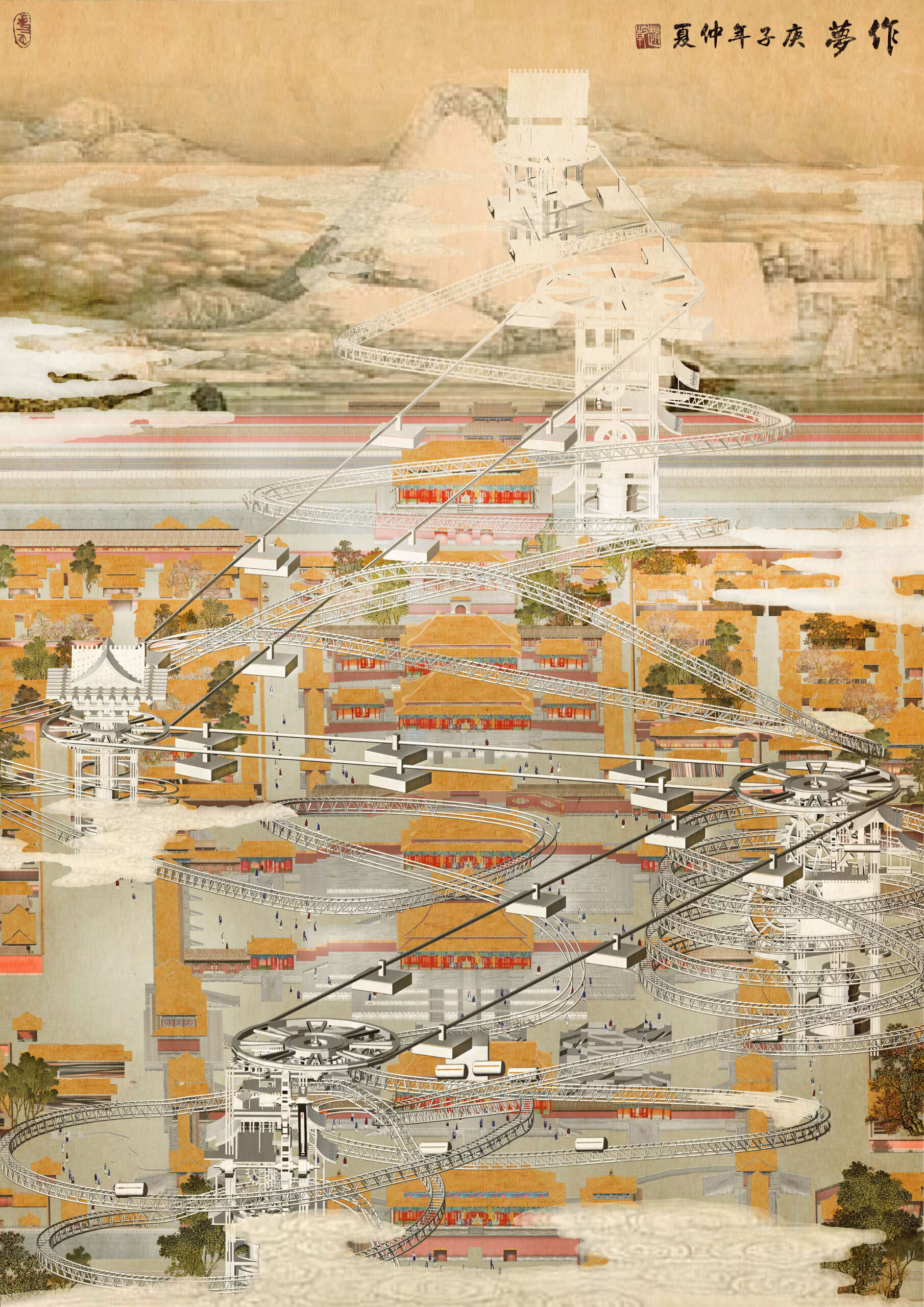
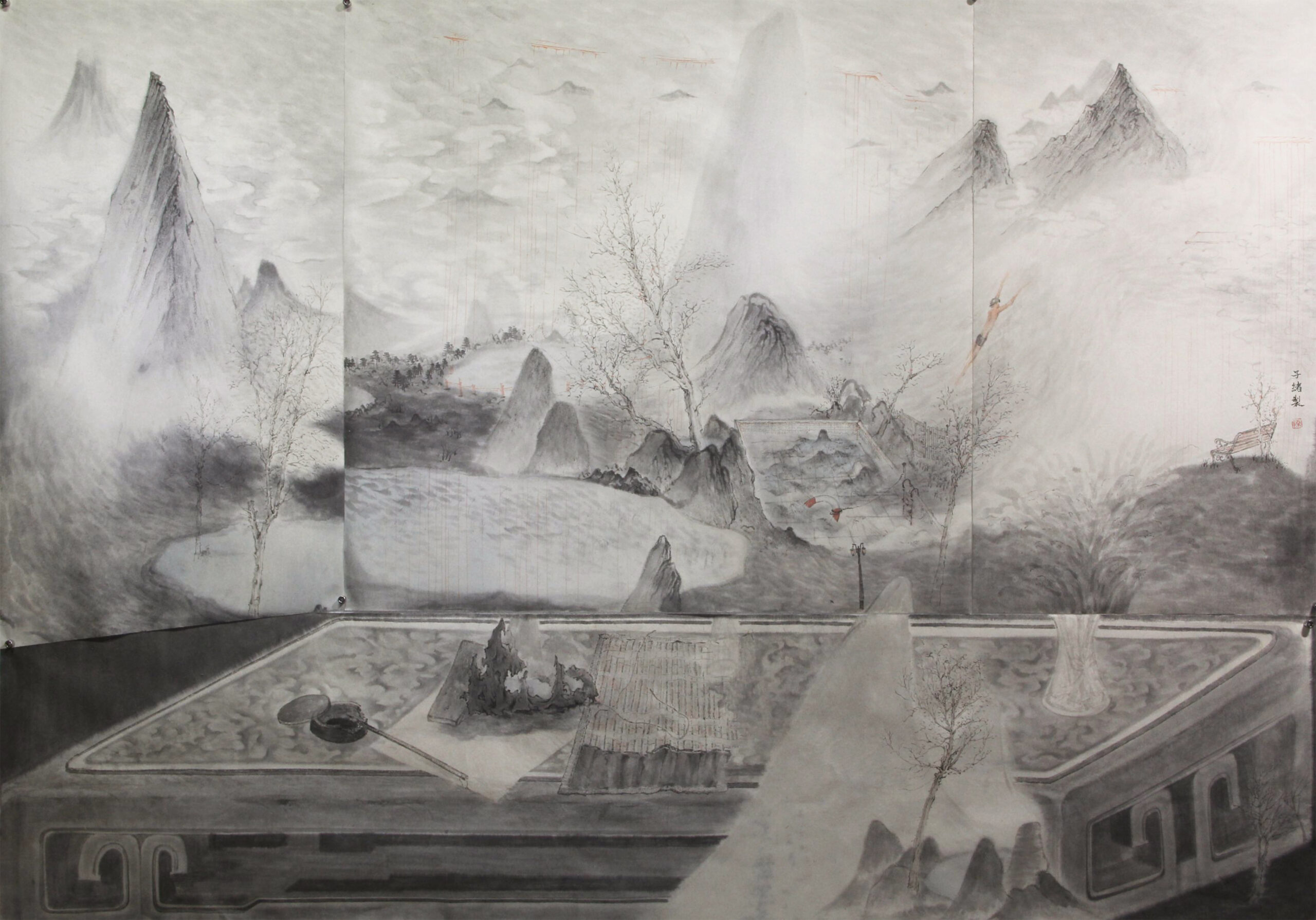
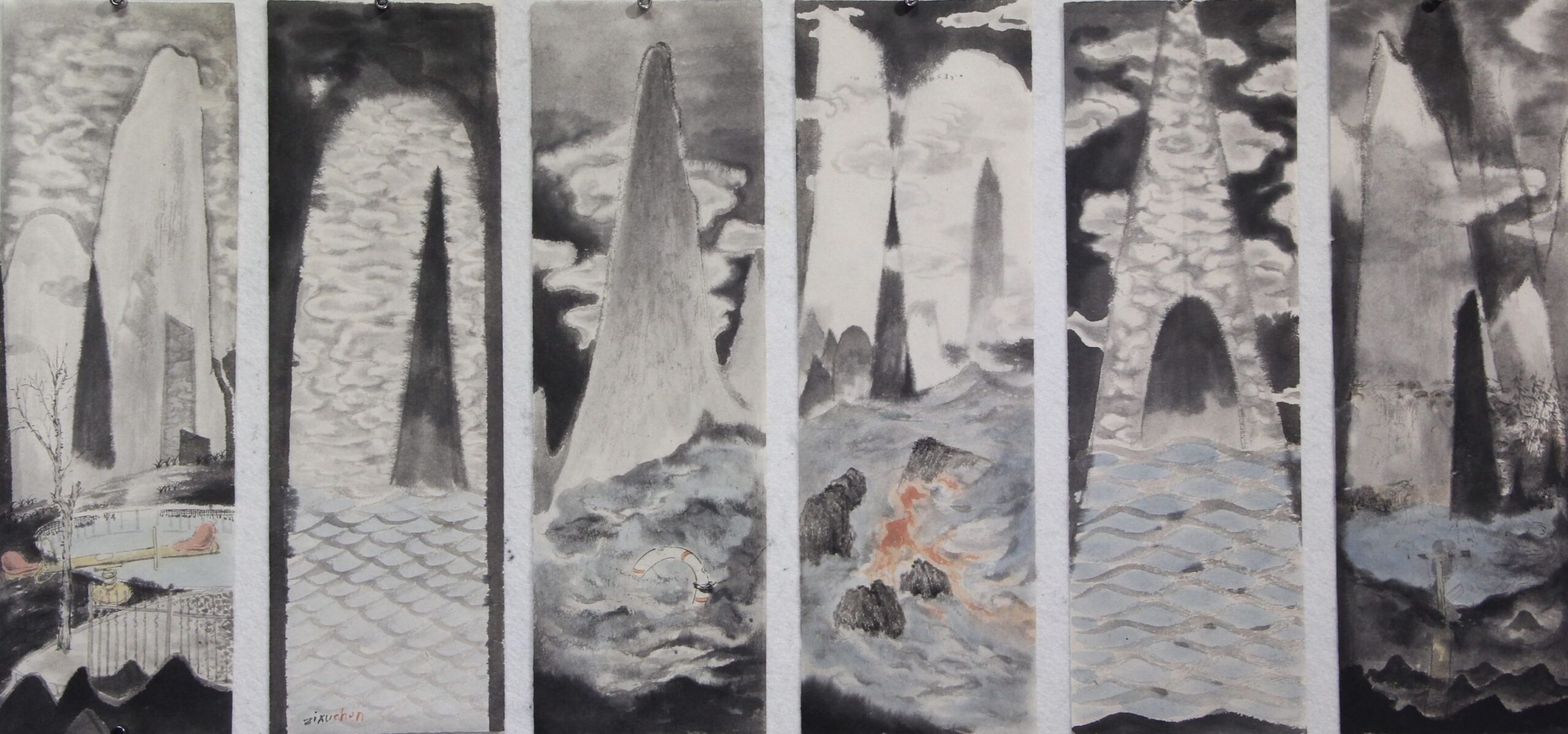
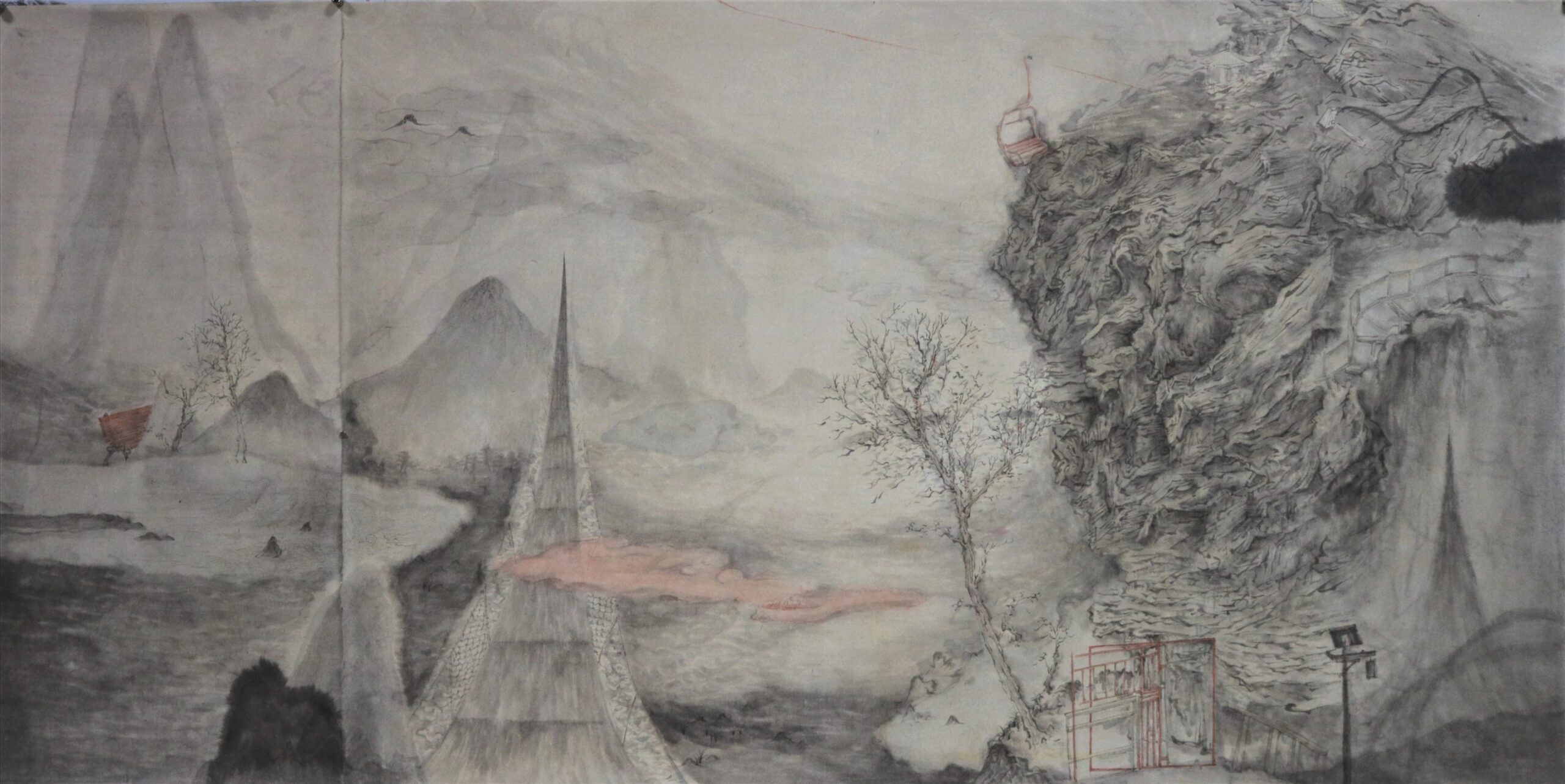
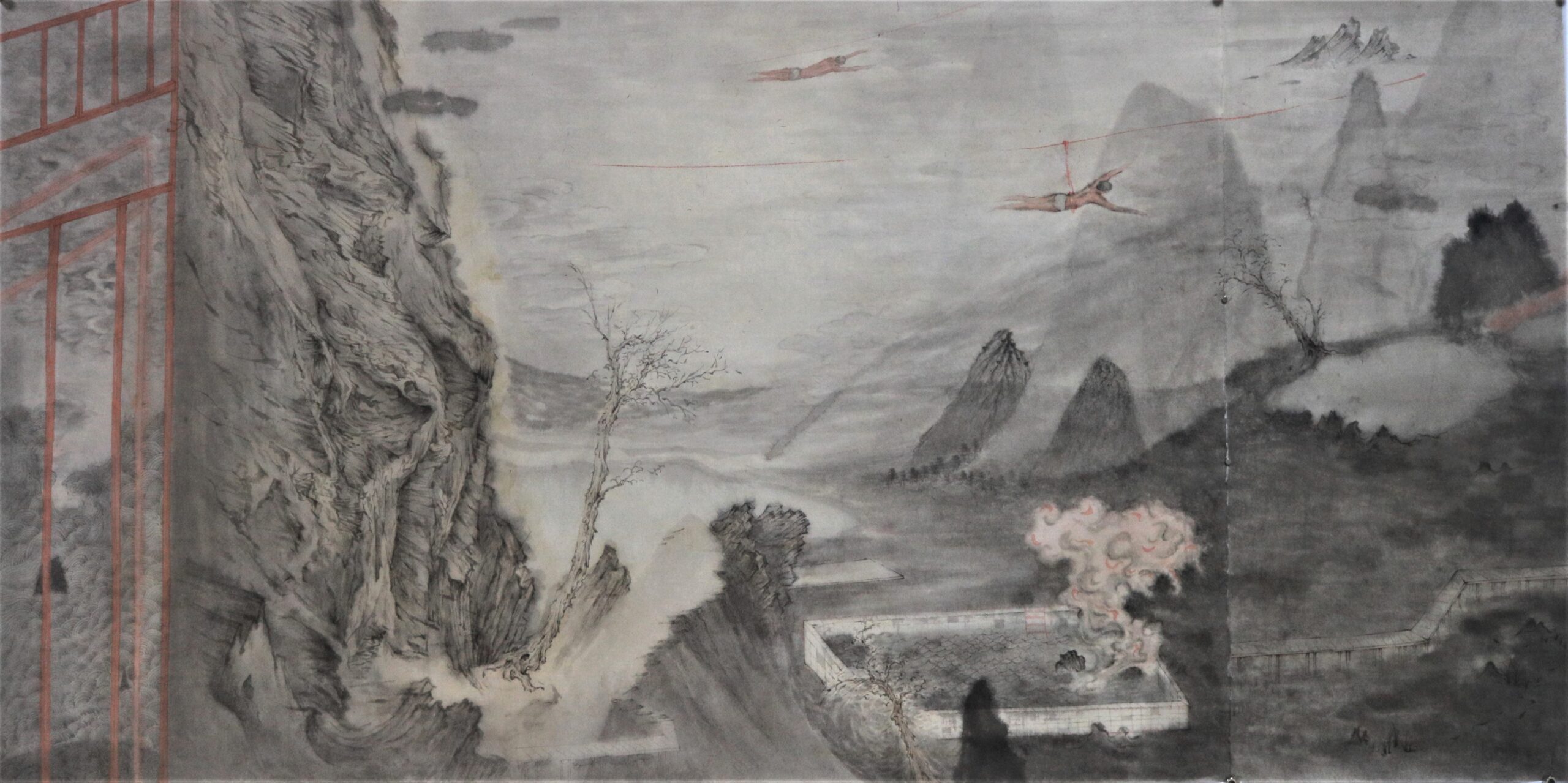

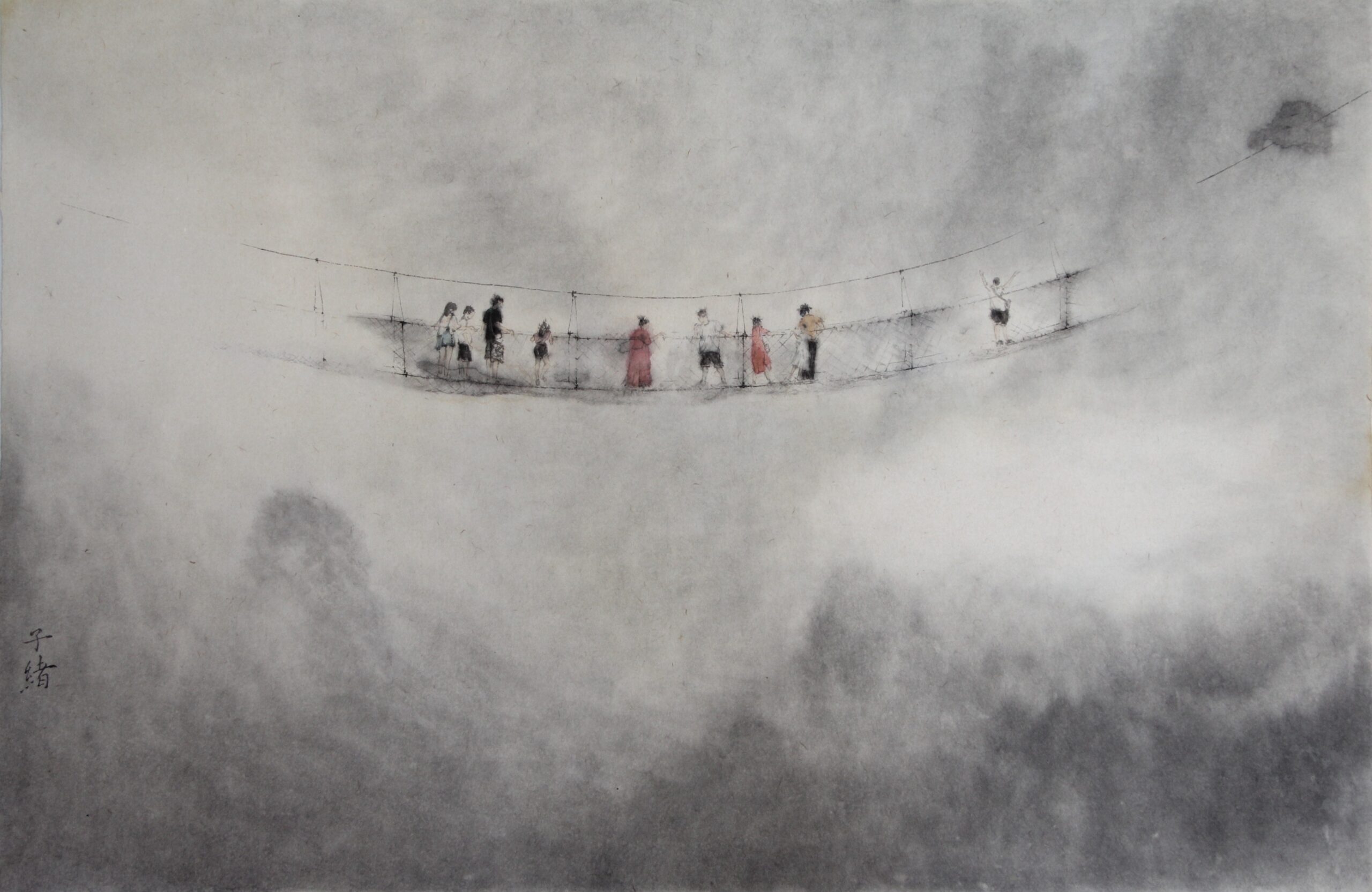
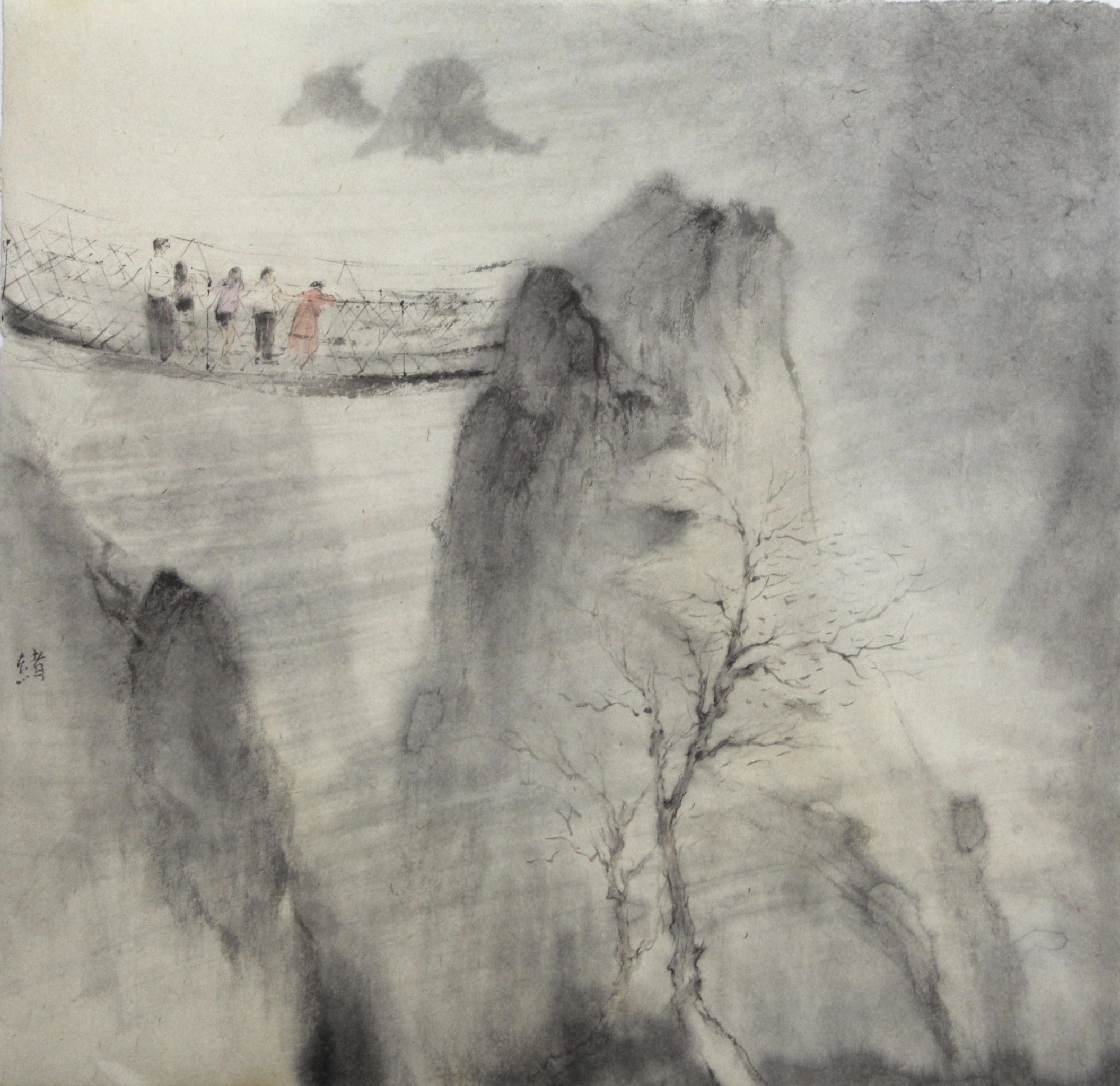
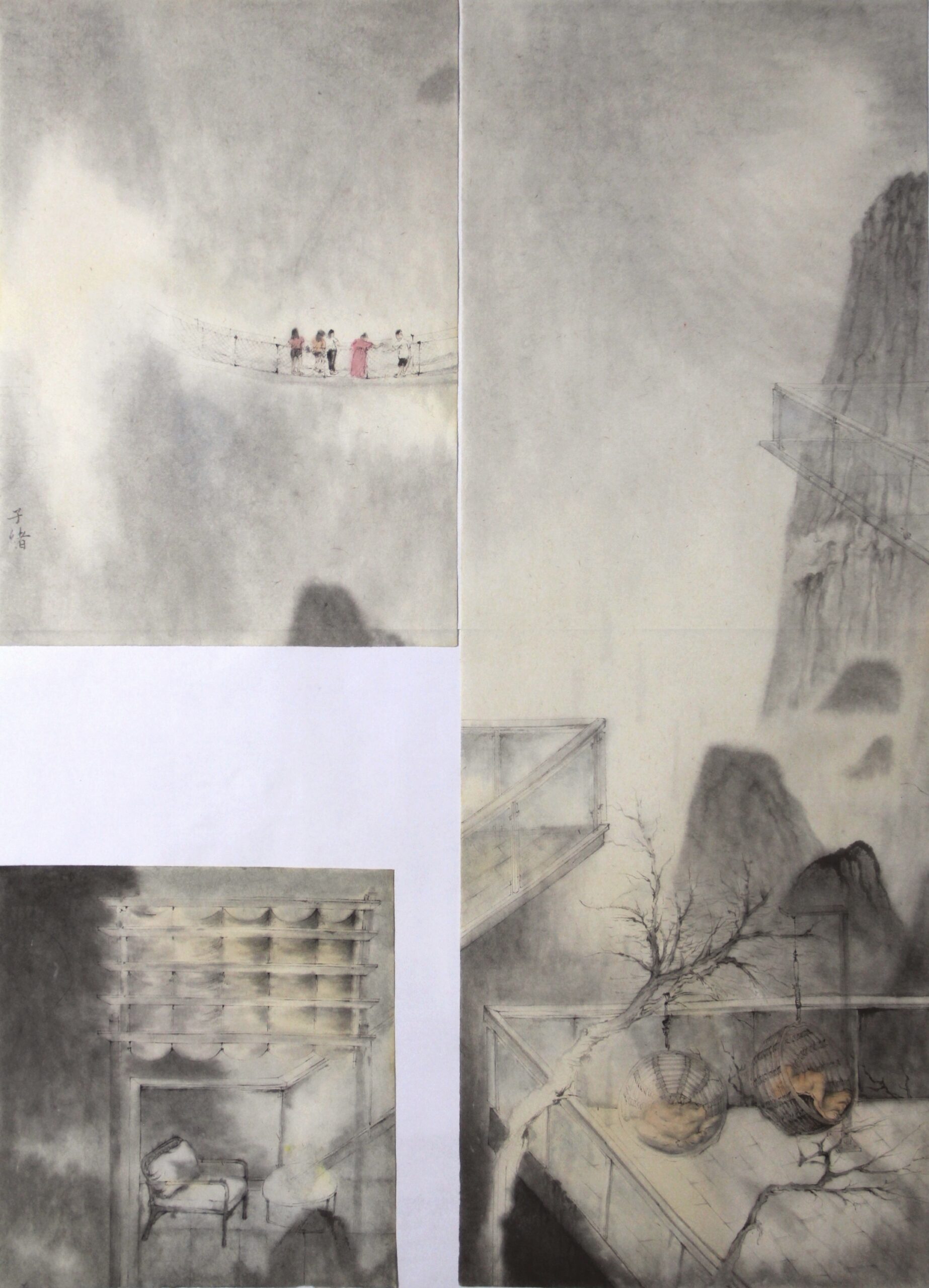
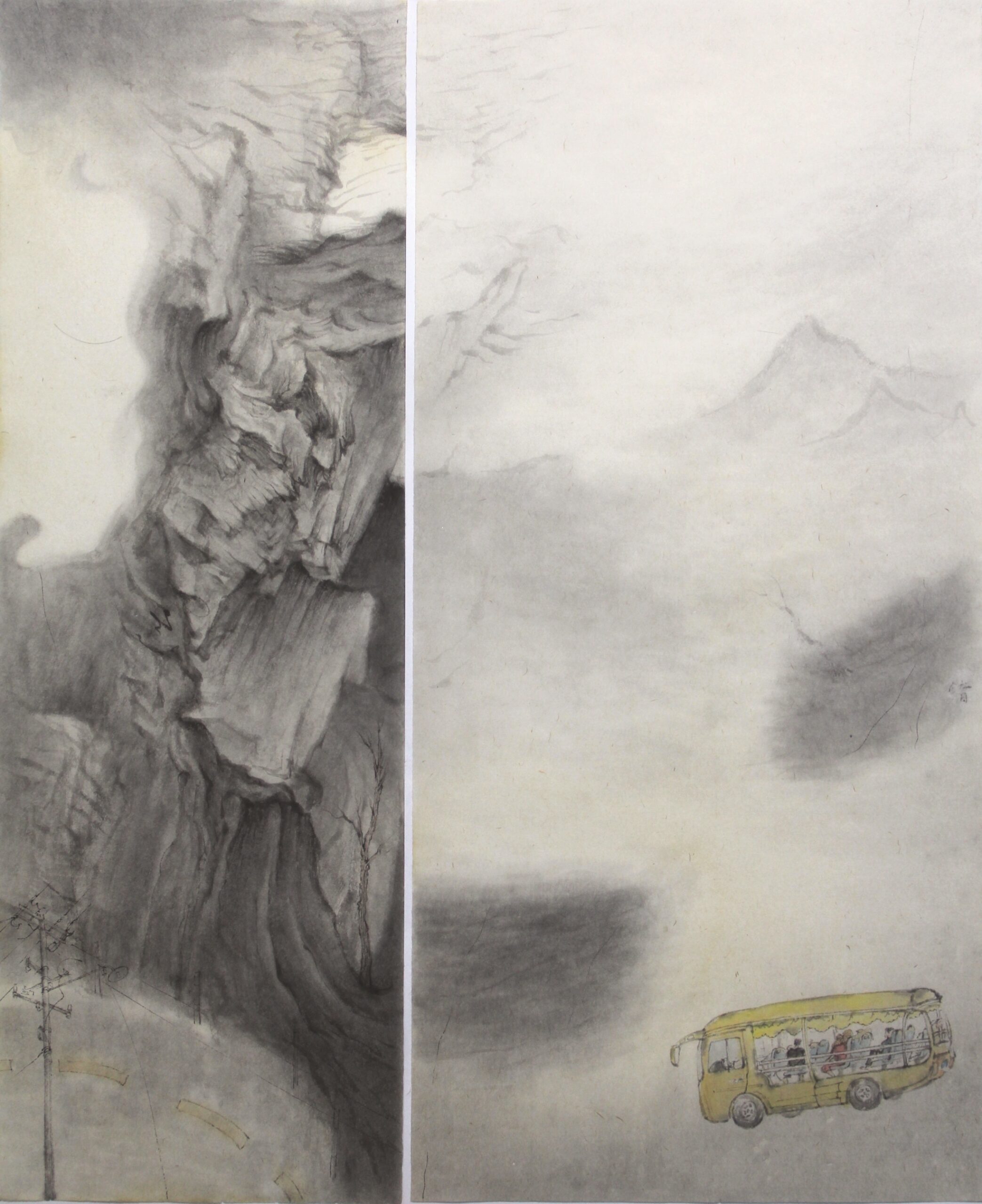
Biography
Qian ZHAO, Pengyu ZHU: Students of Landscape Architecture at Renmin University of China
赵乾、朱鹏宇,中国人民大学景观建筑专业在读学生
Zixu CHEN: Young Artist – MFA Chinese Painting in Chinese National Academy of Arts
陈子绪,青年艺术家 – 中国艺术研究院中国画系研究生
Interview with Zhao & Zhu
The names would be abbreviated as “Cleo” (Cleo CHEN), “ZHAO” (Qian ZHAO) and “ZHU” (Pengyu ZHU).
(之后姓名分别写为“陈昕”、“赵乾”、“鹏宇”)
Cleo: Can you tell us how you organised your life and work during this time? What has been changed?
ZHAO: Before the pandemic, we were in the same class and dormitory at school, so it was easy for us to communicate with each other. The outbreak occurred during our winter vacation, so we could only talk online and at home. My schedule was mostly involved writing papers or graduation projects during the day and then busying myself with other things at night.
ZHU: At that time, the pandemic was serious and the virus was spreading, so I tried not to go outside, and I also felt a little panicky. I seemed to repeat the same routine every day—like searching for materials or creating my artworks at home. The most significant change in this time that I noticed was that everyone around me was now wearing masks.
ZHAO: Now our vaccine programme has been administered widely, and with this, our life has basically returned to normal. Except for we need to report upon entering or leaving our school but there are really not too many restrictions at all.
ZHU: Our lives had returned to normal last summer, but it resurged again last winter.
陈昕:在新冠期间,你们是如何组织工作和生活的?与新冠之前有何不同?
赵乾:疫情前我们在学校是一个班,还是一个宿舍的,所以交流起来很方便。疫情期间是寒假,所以一直在线上沟通,白天写论文做毕业设计,晚上忙自己的事。
鹏宇:当时新冠比较严重,正处于上升期,尽量不出门,心里有点恐慌。每天都在家里找资料做作品。与新冠前的不同是出门身边的人都带着口罩。
赵乾:现在国内疫苗开始大面积接种,气温上升,生活也基本已经恢复正常了。除了进出学校需要报备之类的,已经没有太多的限制。
鹏宇:去年夏天就基本恢复疫情前的生活了,只是冬天又反弹。
Cleo: What changes have you experienced or discovered in this time? Whether it is in your life or your creative work? What do you think is your pivot to cope with the pandemic?
ZHAO: Being able to go out was the aspect of my life that was mainly affected, especially long-distance travelling. We were also asked to show the QR code pass whenever entering or exiting the busy areas. There were also restrictions that limited the number of people that could do activities indoors meaning that our sources of entertainment were limited.
ZHU: In this period too, I think the public has become more disciplined. For instance, people would agreeably wear masks or monitor temperature when getting on the bus but it also felt quieter not only at the bus station but in many places.
My mind has also changed a lot, I used to think that I could get what I want only through my own efforts, but now I find that my world can be affected by many other external factors. What is more, my goal was clearer, I would plan everything in advance prior to the pandemic.
ZHAO: Many unexpected things happened during the pandemic, like not knowing when we would be going back to school, for example. I used to think of myself as an idealistic person, this period made me become more realistic in my daily life but, in art, it has gone the other way from reality to ideal.
陈昕:你们经历过或发现的变化是什么?无论是生活还是创作都可以谈谈。你们认为自己在疫情下的的转折点是什么?(关键问题)
赵乾:生活上是出行受到影响。尤其是远距离的旅行,进出景点需要查二维码,室内的活动有人数流量限制,感觉娱乐活动受限。
鹏宇:公共场合的纪律性变强了。就像人们上公交车前就会把口罩戴好,测体温。不只是在公交车站,在很多地方都感觉群众变安静,纪律性变强了。生活上的事情也改变了我的想法,以前觉得通过自己努力就可以得到想要的,现在发现还有很多其他因素的影响。感觉自己的目标更清晰了,做什么事都应该提前打算。
赵乾:疫情期间很多事情都是突如其来的,像返校时间的反复。感觉自己以前是理想主义的人,疫情让我在生活中变得现实,但在艺术上是从现实变得理想。
Cleo: When did you start to create the artwork Dreaming?
ZHAO: We started this at the beginning of last March. Previously, everyone was optimistic and felt that the virus, the pandemic, everything like that would be over soon. Hence, when it came to the theme of our graduation project in mid-March, I decided that I would like to create an idealistic surrealist artwork, and the work was finished at the end of last May.
陈昕:你们什么时候开始构思《作梦》这个作品的?
赵乾:在3月初开始构思的。一开始大家都很乐观感觉很快就可以消失,3月中定毕设主题的时候,就想做一个理想化的、超现实的作品。在5月底完成了这个作品。
Cleo: I noticed that you are students majoring in landscape design, so what inspired you to create the artwork? Why did you choose to build amusement facilities beyond the Forbidden City (The Forbidden City, as the palace of Chinese Emperors during the Qing Dynasty of Chinese history) rather than beyond other sites?
ZHU: Both of us were art students and we used to paint. Therefore, we would pursue aesthetics and artistry first and, then, we would plan the details when making the landscape which would have the look of architecture about it.
The context of the work was during the increasing severity of the pandemic period. The meaning behind the work, then, was that we hoped that the people who lived in isolation could go outdoors, so the whole building was in sharp contrast with the solemnity of The Forbidden City.
ZHAO: The Forbidden City was closed after the outbreak. So, we used our skills to design and install a temporary landscape for the future for people to enjoy and play to cope with emergencies of the pandemic. It also had the contrast that Pengyu ZHU mentioned before, that the atmosphere of The Forbidden City was very solemn but the one of an amusement park was lively. There was also a contrast between the material selected for this piece – wood and steel which represented the conflict between history and the present. We mainly used this contrast to express the aesthetic and quality differences.
陈昕:我注意到你们是景观设计专业的学生,是什么启发你们着手进行该艺术品的创作?为什么选择把游乐设施建于故宫之上?而不是基于别的景象?
鹏宇:我两都是艺术生出身,以前都是画画的。在景观设计中,第一会追求美观和艺术性,第二做景观的时候会抠细节,会做得像建筑。这个作品的背景也处于疫情上升期,我们是希望居家隔离的居民可以到户外活动,整个建筑和庄严的故宫形成鲜明的对比。
赵乾:故宫在疫情一开始就关闭了。所以我们就利用专业给未来设计一种装置、临时性景观,符合疫情这样的突发情况,可以供人们游玩观赏。还有就是鹏宇说的对比,故宫氛围庄严,游乐场活泼。在景观选材也是有对比的,木头和钢铁,也是历史性和现代化的对比。用对比去表达这样的氛围。
Cleo: In my view, this work also implied that the country was still very optimistic about the pandemic at the beginning. The Forbidden City symbolised the general environment of China while the thoughts of the mass of people were reflected in the amusement park. There is a tangible contradiction between enclosure and optimism.
ZHAO: Yes, it also meant that no matter what kind of difficulties we’re encountering, we could overcome them with a positive attitude.
ZHU: Yeah it felt like the pandemic was a depressing topic, and the pressure of it all might be eased a bit by making an amusement park.
陈昕:在我个人看来,这个作品也有在暗喻国内对疫情一开始还是很乐观的。因为故宫象征中国的大环境,群众的心态则体现在游乐场上,就里面是有乐观和矛盾的心态的。
赵乾:对也有这一层意思,就感觉无论遇到什么样的困难都可以用一种乐观的心态去应对吧。
鹏宇:就觉得疫情是压抑的话题,做成游乐场就有更轻松的一个感觉。
Cleo: What does this work mean to you, then?
ZHU: It represents the end of our undergraduate studies. Then, same as its name, it is a design that emerges from our lived reality but carries our fantasy of The Forbidden City which is illusory and exaggerated.
ZHAO: I agree but, what is more, it is also an attempt at something new. Our previous projects were very realistic but, with this design, we have tried a totally new form of expression—to exaggerate without any restrictions.
陈昕:《作梦》这件作品对你们来说意味着什么?
鹏宇:代表大学学习的结束,其次这个作品和名字一样虚幻、夸张,它是脱离实际的设计,承载着我们对故宫的幻想。
赵乾:我也差不多,但也是一种新的尝试。之前的项目都很现实,这个毕设就想尝试一个新的表现形式,就夸张一点,不受限制太多。
Cleo: Since this work is still very different from the Beijing Folk House Museum that you had created before, so does this mean that you want to develop more in the field of contemporary art? If so, which direction will you take?
ZHU: Actually no, I would still like to be a designer in the future.
ZHAO: I have not thought too much about it yet. I like to experiment and I do not want to be confined in a simple style. All of my previous projects are different from each other.
陈昕:因为这件作品和你们之前的设计的北京民居博物馆还是很不一样的。你们是有想往当代艺术的领域发展吗?那么你们比较想关注的是什么主题呢?
鹏宇:没有,以后还是会做设计师。
赵乾:没细想。我喜欢尝试,不想禁锢在一个风格,以前的项目每个都不一样。
Cleo: How did the pandemic affect your work?
ZHAO: The pandemic mainly impacted the form of the work I did which changed from face-to-face communication to being online. This meant that it was very easy for any information about work to be delayed and that always generated many different issues. And, also, the issues I have mentioned before.
ZHU: The biggest issue was travelling. The health QR code, temperature monitoring, and wearing a mask were quite time-consuming. Mentally, I was sort of concerned at first, but then I got used to the online classes and they even felt quite fulfilling and convenient.
陈昕:新冠对你们的工作有什么样影响?
赵乾:主要是工作形式。从面对面交流,到线上交流,容易消息传达不及时和出现矛盾。还有就是之前提到的出行不便。
鹏宇:最大还是出行的问题。因为健康码、测体温、戴口罩还是挺繁琐的。心理上刚开始有点恐慌,后来习惯线上上课感觉也挺充实、方便的。
Cleo: Has has your perception of art changed since the pandemic? If so, how, exactly?
ZHAO: In fact, there have not been many changes. Art and design were both means of expressing ideas and could reflect current social situations or existing problems. There were some changes in my mindset like, when creating landscapes, we would take this problem into consideration—whether we could have previously prevented some issues that may arise in the future.
ZHU: I feel art has become more fundamental. I used to think of art as something like caviar— it was something only the upper-class people played with and enjoyed, and there is nothing useful about it. After enduring this period, I have found a lot of artistic ideas which emerged from these events, and this made me truly feel that art and real-life were closely related, and art was not just for entertainment.
陈昕:从第一次接触艺术开始,或者在新冠之前,你们对艺术的感觉现在是否发生了变化?具体是什么?
赵乾:没有特别多的变化。艺术和设计都是表达想法的手段,可以去反映一些当代的社会背景和问题。思想上有一些变化,以后会在做景观的时候,更多地会考虑到能不能提前预防未来可能会出现的一些问题。
鹏宇:感觉艺术变得真实了。以前觉得艺术就是阳春白雪、虚无缥缈,是上流人士才玩的东西。疫情爆发后有看到描绘抗疫,抗击西方对中国的诋毁。我可以真实感受到艺术和现实生活是息息相关的,觉得艺术不只是停留在人们的观赏上了。
Cleo: Do you think art would tend to be more online in the future? What might be the relationship between technology and Art in your opinion?
ZHU: Only part of it will go online. It is still the most intuitive way for art to be appreciated physically and, because of this art is something that cannot be copied. Although art can be shared more quickly online, physical exhibitions will still remain mainstream, I think.
Their relationship to me is that art inspires technological development, whether it is through its human application or its design but, in turn, technology will support the innovation of artistic methods for creating and performing.
ZHAO: My ideas are kind of similar to Pengyu ZHU. Like paintings or sculptures, it is very difficult to transfer them online. For example, there may be colour deviations or picture distortions that would be very different to the physical appearance and experience. However, landscape architecture might pivot online.
As for the relationship between technology and art, I think they are complementary to each other. In China, VR, modelling software, virtual exhibiting space and exhibition halls are all being developed in tandem. One day, there might be new art forms along these lines introduced in the future.
ZHU: Being physical and up close to art is still the best way of immersing ourselves in art and feeling its charm.
陈昕:你们认为新冠之后艺术会转向线上吗?科技和艺术的关系在你们看来是什么样的?
鹏宇:只会一部分转向线上。欣赏艺术还是在线下用眼睛看到最为直观,体验无法复制。线上可以及时传播,但线下还是主流。他们的关系在我看来艺术启发着科学发展,无论是人性化、功能性的设计也好,但反过来科技会支持艺术的创新。
赵乾:我的想法和鹏宇类似。像绘画和雕塑很难转移到线上,或许有色差,变形,和直观感受还是不一样的。建筑景观或许会转向线上。科技和艺术感觉是相辅相成的吧。像国内都在探索VR,建模软件,虚拟空间和展厅,在未来或许可以推演出新的艺术形式。
鹏宇:还是身临其境才能感受到艺术的魅力。
Interview with Chen
The names would be abbreviated as “Cleo” (Cleo CHEN) and “CHEN” (Zixu CHEN).
(之后姓名分别写为“陈昕”、“子绪”)
Cleo: How did you do with your life and work during the pandemic? What was changed from before?
CHEN: The outbreak happened during my senior year of college, and I was preparing for my graduation and the preliminary examination for postgraduate. According to the pandemic, the examination was delayed to be held in May or June. Simultaneously, Heilongjiang which is the city I located in was always on lockdown, so as a result of all things mentioned above, I was very depressed those days, the only thing I could do was keep studying.
陈昕:在新冠期间,你是如何组织工作和生活的?与新冠之前有什么不同?
子绪:疫情前是大四,在准备毕业创作和考研初试,考研因为疫情一直拖到5-6月份。当时在东北黑龙江一直在封锁,那段时间很压抑,就一直在学习。
Cleo: Could you talk about the changes you’ve found or experienced during this period? What’s your Pivot like?
CHEN: My normal life has changed a lot. My high school was in Beijing so I seldom wanted to go back because I was used to living independently. However, I became accustomed to staying at home which caused by the pandemic this year. As for my Art creating, I’ve changed my material from colourful ink to wash painting. I have experienced a hard time doing this because my colourful ink paintings were based on sketching, so I could only create wash paintings due to there was no way for me to sketch with the condition of lockdown. I was used to painting with colourful ink, so at first, I felt particularly dull when painting washes painting which only had one colour of black, which actually just in line with my mood at the time. As a result, my later paintings had some elements of the swimming person or lifebuoys.
陈昕:你经历过或发现的变化是什么?你认为自己在疫情下的的转折点是什么?
子绪:生活上变化很大,初中在北京,不想回家。疫情这一年在家就习惯了。在创作上对材料的运用经历从彩墨到水墨的变化。疫情有段时间心情低迷。彩墨绘画我是基于写生,疫情没办法写生,就又回到水墨。水墨的黑白感觉特别的闷,符合当时的心情,所以后来创作的画面也出现了游泳小人和救生圈的元素。
Cleo: When did you start to conceive the work of Settled to Look on the Emerging Clouds《坐看云起时》, Growing Freely-Mountains and Seas 《自由生长 – 山海》, and the Scenic Spot series artwork《景区》?
CHEN: The “Growing Freely” series artworks have started long before, I think it has represented the status of my art creation—some of my paintings were conceived previously while some totally weren’t. I always painted by following my vague feeling, I’d like to pile up elements in my mind, so each element was like a USB flash drive of my memory. “Growing Freely” means that I would start with a tree or a mountain, and then gradually growing out of them with significance.
Settled to Look On the Emerging Clouds was the work I created after graduating. Chinese ancient painting was very different from the West which emphasized forms and colours of paintings. Chinese painting focused on the vivid quality flowing inside the painting. Talking about this, I’d like to emphasize the feature of “vivid quality flowing inside”. Aiming of performing that, I try the painting technique of arranging rows after rows, it was also an attempt of experimenting with the traditional space painting approaches. The sharp peaks painted in the”Mountains and Seas” were like the thorns in my life, so after drawing the thorns “out”, I felt much better than before. The Scenic Spot was the work I’ve just started to work on. This work was inspired by the Taihang Mountain and the Sanya Forest Park that I go for sketching a while ago. Mountains performed in the Chinese ancient painting were mostly innominate ones, but nowadays, most of our painting elements were taken from the scenes spots. Therefore, the work was done. What satisfied me more were the little person standing on the bridge and the viewing platform they were more appealing to me according to my aesthetic standard.
The Scenic Spot was the work I’ve just started to work on. This work was inspired by the Taihang Mountain and the Sanya Forest Park where I went sketching once a while ago. Mountains depicted in Chinese ancient painting were mostly unidentified ones but nowadays, most of our painting elements are from scenic spots. What satisfied me most about this work was the little person standing on the bridge and the viewing platform, they were more appealing to me and my aesthetic standard.
陈昕:你从什么时候开始构思《坐看云起时》、《自由生长-山海》、《景区》等这一系列作品的?
子绪:《自由生长》这个系列很早就开始了,它代表着我创作的状态。我画画有的是提前构思,有的没有构思。我是照着模糊的感觉去画的,我会堆砌元素,每个元素就像是寄托我记忆的U盘。《自由生长》我会从一棵树、一座山开始,然后慢慢生发出来。
《坐看云起时》是我毕业创作的一幅作品。中国古代的绘画和西方有很大的不同,西方讲形色。中国讲气韵生动、气流,我想强调气流,所以尝试用一排一排的手法去表达里面的气和势,这也是我对传统空间的尝试。《山海》里尖尖的山峰就像是生活里的刺,画起来感觉内心会好受一些。然后《景区》是我最近开始的,之前去太行山和三亚的森林公园写生,以前国画的山都是无名山,现在就去的是景区比较多。我比较满意桥上的小人和观景台,是在审美上对我比较有吸引力的。
Cleo: Among all these works, which one do you like best? and why? What has inspired you to create it?
CHEN: I used to like Settled to Look On the Emerging Clouds most because it has my mood and status during my vacation. In addition, because it took a while to paint, it has collected various elements of different painting techniques or languages making it more complete. Whereas now, my favourite is the Viewing Platform, and later, I would like to keep adding the element of the small person depicted in the painting. In terms of inspiration, I admire the brushstrokes of Western oil paintings. I also like Baroque and Impressionist paintings, so later I may enrich my paintings with these sorts of references.
陈昕:你最喜欢哪幅作品,对你来说意味着什么?是什么启发你着手进行这系列的艺术品的创作?
子绪:之前最喜欢《坐看云起时》,它记录我整个假期的状态。画了很久,集合了很多绘画语言,感觉比较完整。现在最喜欢《观景台》,小人元素后期还想继续发展。关于启发,我喜欢看西方油画有笔触的感觉,我也很喜欢巴洛克、印象派的画,想用西方的笔触去丰富画面。
Cleo: I found that these works were very different from the previous sketches, so do you want to go into the field of contemporary art later? If so, which sort of art theme do you want to focus on?
CHEN: I am longing to go into contemporary art. Chinese landscape paintings mainly emphasising the looks of paintings, sometimes I get tired of this aesthetic, so I want to make my pictures look like works that focus on our contemporary world and which cares more about the different meanings of our lives.
European artists such as Gerhard Richter and Anselm Kiefer both suffered a lot during childhood, so their artworks can be viewed as giving us a sense of reflection, guilt, or anger, which are really powerful ideas to convey. However, I am living a normal life, so I often feel that my paintings are too mediocre. I tried living in an intense and extreme manner, but I found it hard for me to use painting to record my reality and ideas. As a result, I may still focus on the expression in the picture itself at the moment.
At present, I still want to imitate more iconic paintings and many contemporary paintings are inspired by ancient themes. Like Lei XU, an artist who aims to promote the spatial feelings expressed in Chinese Landscape Paintings and his paintings are very novel by use of this method. I see this as a great example of a method for generating a symbiosis between the contemporary and the traditional. I thought a lot about this recently, and I feel there are many different potential ways I can pursue these ideas.
陈昕:因为这些创作作品和之前的写生还是很不一样的,你是有想往当代艺术的领域发展吗?那么你比较想关注的是什么主题呢?
子绪:我很向往当代艺术。中国的山水画如果一直强调画面本体,或许会有审美疲惫。我希望我的画面看起来像是关注生活的现代人画的作品。
像西方艺术家,里希特和基弗童年都遭遇过不幸,他们的作品就有一种反思、愧疚、或愤怒,蕴含着很大的能力在画面里。我自己成长历程比较风平浪静,就感觉自己画的东西很平庸,我在尽量让自己极端,但发现很难记录对社会现状的理解。我可能还是会关注画面语言的本身。
目前还想多临摹,中国很多当代绘画都是从非常远古的东西去找的。像南京画家徐累去找中国空间的感觉,用得好的话就非常新颖,就很当代,也是对传统的反思。最近想的很多,感觉路径很多。
Cleo: How does the pandemic impact your art creation?
CHEN: The pandemic presented me with some barriers, and this period also represents my Pivot from undergraduate to postgraduate. Before the pandemic, I lived carefree like being in an ivory tower, but I was forced to pivot to become pragmatic and think about how to make money because my family was suffering from financial pressure.
In response, I developed my learning to focus more on which styles were popular in national exhibitions, and drawing more completely, in order to find a job. Owing to the fact that holding a solo exhibition or academic exhibition was not as convenient as the national exhibitions, I also thought about developing a fixed painting language at this time. It was a hard period, and I found that I work that I once felt satisfied with later revealed itself to me as something which was not what I wanted or intended to produce. Therefore, I had to adapt again to focus on my mood and surroundings, and I’m trying to let myself be satisfied in any given situation.
陈昕:新冠对你的工作有什么样影响?
子绪:疫情让我有一些挫折。因为疫情也是我大学到研究生的转折点。新冠以前上大学的时候,感觉自己在象牙塔里无忧无虑;新冠之后家里有一点经济压力,我变得功利,就在思考怎么画赚钱。就想去学国展上流行的画风,画得完整些,就为了找工作方便。办个展或学术展都没有国展方便。我在思考是不是要寻找固定的语言。那段时期比较难受,之前画的每一张都很满意,现在感觉就不太对了。我创作还是会基于心境和环境的变化吧。这几年在努力让自己任何情况下都画的很满意。
Cleo: Has your perception of art been changed now since the pandemic, and can you talk about these changes?
CHEN: At first, I did not think too much about art, it was just something aesthetic. This thought shifted changed during my second year of high school, though, when I went to the Chinese Academy of Fine Art High School. During my studies, I discovered that Art has a huge impact on our society and does so in a lot of amazing ways, for example, in Western Art history, there is the impact of the Renaissance, Romanticism, etc. To my surprise, Chinese Art had a period of realism, similar to this, which also left behind a positive legacy. I also came to feel the Religious power involved in art when I took up my studies. As for contemporary art, I am developing a technique whereby I try to make my work reflect society from an artistic, aesthetic point of view.
陈昕:从第一次接触艺术开始,或者在新冠之前,你对艺术的感觉现在是否发生了变化?是什么?
子绪:刚开始画画的没想太多,是初二,去考央美附中,当时觉得画画就只是画画,是一个审美的东西。后来发现艺术对于社会来说真的很重要。我也喜欢西方美术史,文艺复兴,浪漫主义。中国也有现实主义的时期,当时也起到很有积极的影响。就能感受到美术的宗教力量。不光是审美的东西,还有很多社会性在里面。想到当代艺术,就还在思考我的作品是要反映对社会的理解,还是从审美出发,画一座好看的山还是什么的。这是我目前在思考的问题。
Cleo: Do you think art will be predominantly online after this period? What is the relationship between technology and art in your opinion?
CHEN: There are many more online exhibitions and each one keeps getting better than the last. And also, the maturity of online art courses is helpful for art’s dissemination.
On the relationship between art and technology, the development of photography has helped art’s development rather than just being a tool of recording a moment and has contributed to art technologically. For instance, an example from history, the moment of the ballerina lifting her leg in Degas‘s painting, The Ballet Class (La Classe de danse), was probably aided with the help of a camera. The printing technique produced photo albums which helped art’s education a lot. So, to end and, in my opinion, the development of technology has smashed down barriers to aid art’s development and I think this will continue.
陈昕:你认为新冠之后艺术会转向线上吗?科技和艺术的关系在你看来是什么样的?
子绪:首先是线上的展览越来越多,越做越好。其次,艺术网课的成熟对艺术传播是一件好事。此外,照片的出现导致观看的方式不一样,对创作也产生很大影响。德加把人直接切一半的构图,芭蕾舞演员抬腿的瞬间很可能是借助照相机,照相机可以把现场的瞬间捕捉得更深入。画册的出现让学习艺术变得更方便了,总的来说,就是科技的发展让学习艺术的门槛降低了吧。
Staff
Host: Cleo CHEN
Contact Person: Ifance FAN, Cleo CHEN
Planner: Cleo CHEN
Text: Cleo CHEN
Translator: Jiaqi GAO
Proofreading: Calum BAIRD
